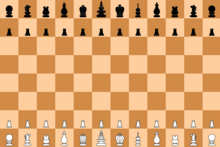Courier game

The courier game , also known as courier chess , is a historical chess variant that was played on a widened chess board of 12 by 8 fields. Several additional pieces were added to the well-known chess pieces , including the courier , which gave the game its name.
Historical meaning
The game, first mentioned around 1210, was quite common in German-speaking countries and the Netherlands in the Middle Ages and at the beginning of the modern era. A picture by the painter Lucas van Leyden from the beginning of the 16th century, which is in the Berlin Gemäldegalerie , bears witness to this . It represents a scene that can only be distinguished from chess on closer inspection - and is therefore called a "game of chess".
The courier game was particularly cultivated in the village of Ströbeck , in addition to chess, which was played in Ströbeck with somewhat modified rules. On the back of the chessboard that the Great Elector gave to the Ströbeckers in 1651, a courier playing field has been incorporated.
The board game takes its name from a special game figure, the courier (from Latin currere = to run), who drew after the long-stepped move of the later runner . When the medieval Alfil , who jumped diagonally into the next but one field, to the bishop in the course of the reform of the chess game , the courier probably served as a model. A piece that corresponds to the bishop is also known from another medieval chess variant, the Grande Acedrex . In any case, it is obvious to associate the courier with the German name of the new chess piece.
Pawns and rules
Gustavus Selenus described the rules of the courier game practiced in Ströbeck in the first German chess textbook , which appeared in 1616. Both players have 24 pieces each on the extended board, which are positioned on the first two rows as in chess. Behind the twelve pawns stand on the first row from left to right: Rook, Springer, Alfil (called "the old man"), Courier, Man, King, Queen, Schleich, Kurier, Alfil, Springer and Rook.
In addition to the courier, there were two other novel characters. The man or council could draw as a “fighting king” like this one, but without the restrictions imposed by possible chess laws . The Schleich (the Queen's Council moves like the vizier ) could move a square horizontally or vertically. The queen did not correspond to today's queen , but moved a square diagonally like the medieval Fers , the forerunner of the queen. In addition, the farmers did not have the double step into the fourth row. The pawn conversion did not go as it is today either, the pawn had to make three happy jumps back to his starting square before he could convert there, and he could meanwhile also be defeated. Apart from the new pieces, the rules knew only minor deviations from chess, but the details of castling (or the king's jump ) are unclear.
After Selenus, some initial moves were finally determined. Both parties moved the pawns in front of the towers and the queen two steps forward. The queen made a one-time leap for joy into the third field. Such starting positions, so-called tabijen , were in principle not unknown in medieval chess. The opening of the courier game was also integrated into the rules of Ströbeck chess.
Lapse of the game
The courier game with its new characters was an early form of fairy tale chess . It represented an alternative to the medieval game of chess, which was sometimes felt to be a bit cumbersome. Interest in the game apparently declined after the transition to modern chess occurred. An exception was the village of Ströbeck, where it was no longer played often, but was demonstrably still played in 1885. The traditional rules go back to a chess congress held there in the same year, the program of which included a competition in the courier game.
In 1988 the program "Distant Armies" appeared, a chess simulation in which courier chess could also be played. In the game itself, reference is made to the village of Ströbeck. The game that was released for Amiga and Macintosh is only available as an antiquarian today.
literature
- Rick Knowlton: Courier Chess . (PDF; 392 kB) In: The Chess Collector , Vol. 28, No. 1, 2009, pp. 13-17
Web links
- Explanation of the rules of the game courier (English)
- Play opportunity "Courier Chess" (Java interface)
- Information from the Ströbeck chess club on the courier game
- schachverein-stroebeck.de
Individual evidence
- ↑ For Germany and Switzerland cf. Hans Ferdinand Maßmann : History of the medieval, preferably the German chess game . Quedlinburg 1839, pp. 157-164 (reprint Leipzig 1983)
- ↑ The “courier chess figures” shown in the painting by Lucas van Leyden have recently become available in stores. See the commercial website courierchess.com
- ^ David Parlett : The Oxford History of Board Games . Oxford 1999, p. 305
